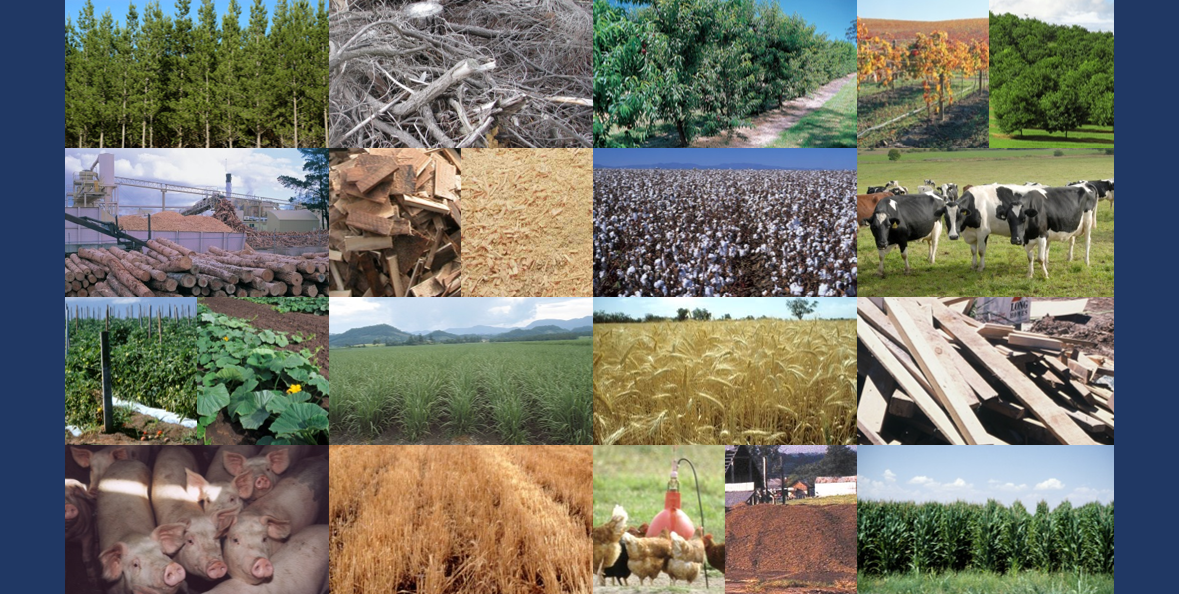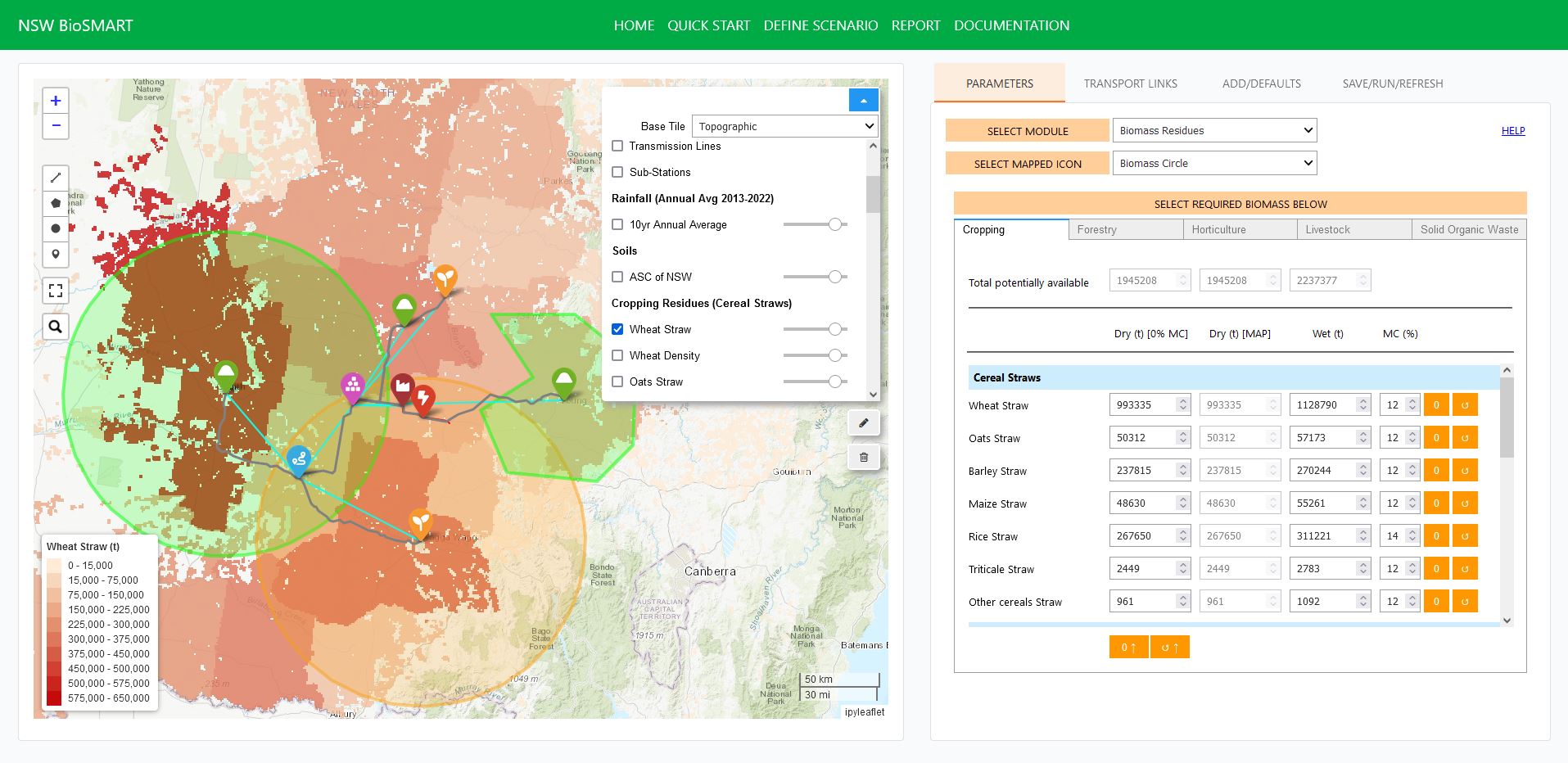
Australian Biomass for Bioenergy Assessment (ABBA) Project
The Australian Biomass for Bioenergy Assessment (ABBA) Project ran from 2015 to 2020 and was funded by the Australian Renewable Energy Agency (ARENA). The NSW DPI Forest Carbon team was responsible for the biomass data collection and will continue as custodians of the New South Wales biomass datasets. The purpose of the ABBA Project was to catalyse investment in the renewable energy sector through the provision of detailed spatial information about biomass resources across Australia, which can assist in project development and decision making for new bioenergy projects, and provide linkages between biomass supply, through the supply chain, to the end user.
NSW spatial data on the National Map
To achieve this, the project collected, calculated and mapped, on a state by state basis, data on the location and potential volumes of biomass from a wide range of industries for inclusion on the National Map platform. Click - Add Data > Energy > Renewable Energy > Bioenergy > New South Wales to access the NSW statewide biomass spatial datasets. Every dataset has detailed information about the calculation of the residues. Toggle between the different residue layers loaded and click on a polygon on the map to return information about biomass in that location for the active layers. Use the side-by-side tool to compare two layers.
The key NSW biomass sources that have been captured so far are listed below.

- Forestry harvesting and sawmilling residues
- Agricultural cropping residues
- Agricultural livestock manure residues
- Horticultural crop residues
- Solid Organic Waste - Municipal Solid Waste (MSW); Construction & Demolition (C&D); Commercial and Industrial (C&I)
- National layers including sugarcane and winery residues
The data can be viewed in conjunction with a multitude of other relevant spatial layers on the National Map, to enhance the visual interpretation and understanding of the data and its location in relation to other biomass sources, towns, transport networks, electricity networks, ports, existing landuse, population statistics and many more.
NSW spatial data in the NSW BioSMART Tool
NSW BioSMART is an interactive spatial tool that enables users to determine the potential for using biomass in NSW for a range of applications. The biomass data within the tool is derived from the ABBA spatial data plus additional spatial data identifying potential lands suitable for new woody biomass crop plantings.

The need for a biomass analytical tool has long been identified as essential to support the growth of a viable biomass industry and we have developed this tool under the Biomass for Bioenergy Project. The tool is built so users are able to vary most default parameters as required. The underlying ABBA biomass data will be kept current by NSW DPI.
Version 1 of the tool has focused on electricity generation options as the end use for biomass - future versions will include other end use options including industrial heat applications, liquid biofuels and biochar.
NSW ABBA biomass residues - interactive chart and table
This interactive chart allows the user to explore the currently calculated NSW biomass residues through an infographic, displaying both the total residues and the percentage share of the group for the state. Note that this is not an exhaustive list of potential biomass available in NSW, but matches what has been captured by the ABBA mapping.
The current capture timeframe for the NSW ABBA biomass groups, represented on the National Map and reflected in this infographic and the table below are listed here. The volumes presented are the annual average of these timeframes.
- Cropping group: 2013-18 FY (5-year annual average)
- Except Sugarcane residues: 2010-15 FY - National layer
- Organic Waste group: 2015-18 FY (3-year annual average)
- Forestry group: 2011-15 CY (5-year annual average)
- Livestock group: 2010-15 FY (5-year annual average)
- Horticulture group: 2013-18 FY (5-year annual average)
- Except Winery residues: 2017 CY (1-year) - National layer
Additional datasets may be included subject to availability of funding. This interactive chart is not fully accessible - see the table below the interactive chart which contains the data behind this infographic.
How to use the interactive chart
The chart contains three levels of information. Hover over the chart to see a snapshot of the residue volumes and the categories below this level. Choose a level: Level 1, Level 2 or Level 3 to explore the data in more or less detail.
- Level 1 - contains the total volume and percentage share of residues calculated for a defined group (Cropping, Organic Waste, Forestry, Livestock and Horticulture)
- Level 2 - contains a more detailed look at the categories that make up the Level 1 groups (such as Cropping - Cereal Straw, Non-cereal Straw, Sugarcane Residues)
- Level 3 - contains the most detailed information and delves into the residue classes that make up the Level 2 categories (such as Cereal Straw - Wheat Straw, Barley Straw, Rice Straw)
Table of NSW ABBA biomass residues
| Level 1 | Level 2 | Level 3 | |||
|---|---|---|---|---|---|
| Group | Volume (DT) | Category | Volume (DT) | Residue Class | Volume (DT) |
| Cropping (2013-18 FY annual average) | 12.2M | Cereal Straw | 8.41M | Wheat Straw | 5.66M |
| Barley Straw | 1.43M | ||||
| Rice Straw | 611K | ||||
| Oats Straw | 295K | ||||
| Sorghum Straw | 221K | ||||
| Maize Straw | 131K | ||||
| Triticale Straw | 51.2K | ||||
| Other Cereals Straw | 5.07K | ||||
| Non-cereal Straw | 1.97M | Canola Straw | 1.35M | ||
| Cotton Straw | 426K | ||||
| All Pulses Straw | 166K | ||||
| Other Oilseeds Straw | 31.9K | ||||
| Peanuts Straw | 824 | ||||
| Hay and Silage | 1.2M | Cereal Hay | 386K | ||
| Lucerne Hay | 298K | ||||
| Silage | 233K | ||||
| Pasture Hay | 219K | ||||
| Other Hay | 59.3K | ||||
| Sugarcane Residues (2010-15 FY annual average) | 511K | Bagasse | 258K | ||
| Sugarcane Trash | 253K | ||||
| Rice Hulls | 108K | Rice Hulls | 108K | ||
| Cotton Gin Trash | 41.4K | Cotton Gin Trash | 41.4K | ||
| Level 1 | Level 2 | Level 3 | |||
| Group | Volume (DT) | Category | Volume (DT) | Residue Class | Volume (DT) |
| Organic Waste (2015-18 FY annual average) | 6.59M | Municipal Solid Waste (MSW) | 3.16M | Vegetation or Compost | 1.66M |
| Food | 999K | ||||
| Paper or Cardboard | 447K | ||||
| Wood or Wood Products | 51.1K | ||||
| Commercial & Industrial (C&I) | 2.6M | Paper or Cardboard | 1.47M | ||
| Wood or Wood Products | 462K | ||||
| Vegetation or Compost | 394K | ||||
| Food | 271K | ||||
| Construction & Demolition (C&D) | 837K | Wood or Wood Products | 649K | ||
| Paper or Cardboard | 98.8K | ||||
| Vegetation or Compost | 89.6K | ||||
| Level 1 | Level 2 | Level 3 | |||
| Group | Volume (DT) | Category | Volume (DT) | Residue Class | Volume (DT) |
| Forestry (2011-15 CY annual average) | 2.25M | Harvest Residues | 1.55M | Native Forests | 974K |
| Softwood Plantation | 490K | ||||
| Hardwood Plantation | 81.5K | ||||
| Sawmill Residues | 701K | Softwood Plantation | 434K | ||
| Hardwood Plantation-Native | 266K | ||||
| Livestock (2010-15 FY annual average) | 1.26M | Manure Residues | 1.26M | Dairy Manure | 659K |
| Poultry Manure | 550K | ||||
| Piggery Manure | 55.3K | ||||
| Horticulture (2013-18 FY annual average) | 159K | Winery Residues (2017 CY only) | 121K (WT) | Grape Marc | 96.4K (WT) |
| Grape Stalks | 24.8K (WT) | ||||
| Nut Residues | 37.4K | Macadamia Husks | 17.7K | ||
| Macadamia Shells | 10.1K | ||||
| Almond Hulls | 7.44K | ||||
| Almond Shells | 2.2K | ||||
*Key: DT = dry tonnes and WT = wet tonnes.
Contact us
For information about this project please email:
Fabiano Ximenes | Leader & Senior Research Scientist
fabiano.ximenes@dpi.nsw.gov.au
Catherine Carney | Research Officer
cath.carney@dpi.nsw.gov.au

